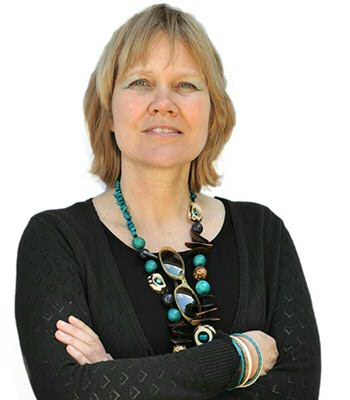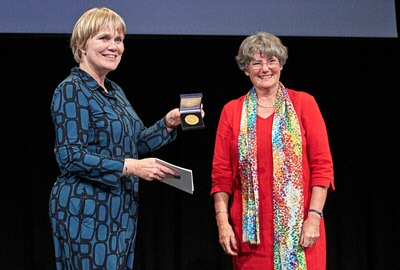Have a cup of tea with an alien
What consequences could the discovery of extraterrestrial life have on humans? That was this year's theme for the annual essay competition held by the Royal Holland Society of Sciences and Humanities (KHMW) and the NRC newspaper. Dr Mathilde van Dijk, lecturer in the History of Christianity and Gender Studies at the Faculty of Theology and Religious Studies, won the award with her essay, provided below.

News item, 16 October 2619
Watched by a large audience, President Philippa Burcht today unveiled the Extra-terrestrial Monument in Amsterdam. The monument depicts two intertwining figures, which change colour and shape every hour to symbolize the diversity of life in outer space. It is the last in a series of monuments that have been placed on various planets over the past hundred years. In her speech, Burcht expressed her hope that the statue ‘would put an end to hundreds of years of colonization and discrimination’ and ‘mark the beginning of a future of equality and thriving relationships.’ The initiator, Xstrhylr, was less optimistic: ‘I'm obviously pleased that we've come this far, but there is still a long way to go before the Terraneans fully accept our extra-terrestrials. ’
The concept of life anywhere but on Earth is a science fiction cliché. But astronomers are discovering more and more planets that may have supported (or perhaps still support) forms of life. It only seems to be a question of time until the first contact – the moment that we discover a planet with inhabitants, or that they discover us. What would the consequences be?
In science fiction, the emphasis is on encounters between intelligent beings, most of which appear to be humanoid: they have two arms, two legs, they breathe oxygen and are divided into two genders, although they can sometimes switch sex. The more they resemble us, the friendlier they are. Some species are even attractive to humans, so that we can fall in love with them and vice versa. But the more scales, tentacles or other repugnant features that they have, the more evil they become, with the monster from the Alien film series (1979-1997) designed by H.R. Giger as the absolute pinnacle. Slimy, with metal teeth and acid instead of blood, this monster slaughters one spaceship crew after another until it finally meets its match in Lieutenant Ripley (in every single film). As the series progresses, it becomes increasingly clear that monster and man are engaged in a Darwinist battle: which species will survive at the expense of the other? Yet even this monster has two arms, two legs and walks upright.
In fact, all things considered, there are very few stories in which the extra-terrestrial beings do not bear some resemblance to humans, animals or even plants. The nebula through which Captain Janeway and her crew try to fly in Star Trek: Voyager (1995, season 1, episode 6) is a rare example. The crew gradually realizes that the nebula is actually an intelligent organism and that their flight has caused it pain. On discovering that they have wounded this curious creation, they do all they can to heal it, as befits any good-natured Star Trek crew. It is worth mentioning that the Star Trek universe portrays happy multiculturalism, albeit between humanoid beings.

Two scenarios
In popular culture, there only seem to be two possible scenarios for contact with extra-terrestrial beings: respectful interaction as we see in the Star Trek series, or a struggle for survival as depicted in Alien. History has taught us that the second scenario is more in keeping with Earth. Europeans and their descendants have a long history of repressing and exploiting people who look different or who are less technologically advanced than themselves. They are by no means unique in this. Non-Europeans had not yet reached ‘our’ degree of civilization, so repressing them was entirely acceptable. The Kingdom of the Incas was totally obliterated in the search for gold. Africans were sold into slavery en masse. These days, young Afro-American men are shot by the police for no apparent reason, native American and Canadian women are raped in the USA and Canada while the perpetrators go unpunished, and in the Netherlands, girls and women wearing the hijab are harassed and sworn at.
Aliens turned into slaves
If even minimal differences between people, such as clothing and skin colour, can cause such serious problems, how will we cope with extra-terrestrial beings? The likeliest outcome is that we would colonize them and turn them into slaves. In the Netherlands, it took us hundreds of years to abolish slavery, over a century to erect a national monument, even longer to formally apologize, and even now, the chances of good education or a job are not exactly what one would call equal.
And this is without mentioning what might happen if we find a planet inhabited by unintelligent life forms, or at least life forms that mankind currently does not recognize as being intelligent. Any such planet might be a habitat for animals that we can eat or kill for their fur or to make leather. And there might be fertile soil that we can use for agriculture or mining. We could solve all the world’s hunger and energy problems in one go, not to mention over-population. The plants that grow there could be used to produce medicines for incurable diseases. People could build a new future there or we could use this new world as a site for hazardous, unhealthy factories manned by robots, which we could operate remotely from Earth. Meanwhile, the native animals would all become extinct and nature would be destroyed.
Lord of Creation
The scenario described above seems inevitable if we continue to treat the world as a conquered land and see ourselves as the Lord of Creation. Eco-philosophical and eco-theological movements are arguing the case for a different attitude: we must see the Earth as a loving mother, who we should treat with care and respect. In this scenario, other planets could be our aunts. Interacting with other species is even more difficult. Getting to know each other is the only thing that helps; having a cup of tea together. Let’s not forget to talk to the people who are in favour of an ethnically homogeneous society. They are afraid that the national character may be ‘diluted’, so they must be having nightmares at the idea of being overrun by blue or green creatures with tentacles or horns. We must convince them that the only option is to work together, now as people and possibly later with creatures from another planet.
But what would happen if they were to discover us before we discover them? Let’s hope it would be more like Star Trek than like Alien, otherwise things might look pretty grim for us...
- More information and Van Dijk's reaction.
